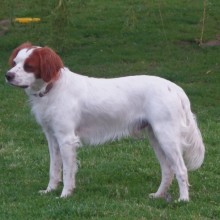Brittany Spaniel
Lifestyle Needs

As his name suggests this Spaniel originates in France and belongs to the hunt, point and retrieve breeds. He is fairly lively, affectionate and easy to train. He is suitable as a pet dog but will require plenty of exercise (two hours a day) and some mental challenges to keep him happy. His coat is soft and silky but generally not as long as some of the other Spaniel breeds. Nevertheless he will need grooming at least twice a week. Ideally he should live in the country where he has access to open spaces for free running. A large secure garden is essential as well.
Genetic Diversity
(Known as Coefficient of Inbreeding: 'COI'. It should be as low as possible.)
The UK Kennel Club breed average COI is 5.8% - See 'A Beginners Guide to COI'
Gene Pool Size
(Known as Effective Population Size: 'EPS')
104.5
EPS is a measure of how many individuals are contributing genetically to a breed population. It is a measure of the size of the gene pool in a breed. Lower than 100 is considered critical by conservationists and below 50 brings a breed close to extinction. For more information see the Kennel Club article.
Health and Welfare Problems due to Conformation
(Body shape and physical characteristics)
The Brittany is a dog without physical exaggerations but care will need to be taken to make sure that his ears are clean. Longish, hairy ears are prone to pick up seeds and other debris. Soreness and infection can occur if care is not taken.
BVA/KC Health Schemes: www.bva.co.uk/chs
- Hip dysplasia: breed 5 year mean score 15.2 (ideally parents should be lower)
- Elbow dysplasia: score ideally 0:0
- Eye disease: full ophthalmological testing required before breeding
Estimated Breeding Values (EBVs) : No EBVs are currently available for this breed
www.thekennelclub.org.uk/about-ebvs
DNA Tests Available
DogWellNet and IPFD Harmonisation of Genetic Testing for Dogs (HGTD)
www.dogwellnet.com/breeds
- C3 Deficiency
- Exercise Induced Collapse (EIC)
Availability of a DNA test does not mean that it is always necessary or even desirable for breeders to use this test.
Other Breed-Specific Health Screening Schemes
None known
Ask the breeder to show you the certificates for the above tests/screening for both parents. If any of the above tests have not been considered necessary by the breeder (and there may be good reasons), ask her to explain why.
Other Diseases Reported
(For which there are currently no genetic or screening tests for sire or dam)
- Otitis externa
- Sterile nodular panniculitis
- Cancer – thyroid neoplasia
- Spinal muscular atrophy
- Eye disease: Primary lens luxation (PLL); sudden acquired retinal degeneration
- Renal amyloidosis
Ask the breeder about the medical history of the parents, grandparents and great grandparents. Consider carefully whether to purchase a puppy if some of these or other diseases are in the family line.
Ask about the breeder’s policy in cases of serious genetic diseases occurring to your puppy in later life. Good breeders will request to be informed of such events in order to improve future breeding decisions.
You are strongly advised to buy from a breeder who uses (or is prepared to use) the AWF Puppy Contract and Puppy Information Pack (PIP): www.puppycontract.org.uk
The breeder should also be familiar with the CFSG/DBRG Code of Practice for Dog Breeding